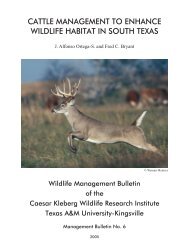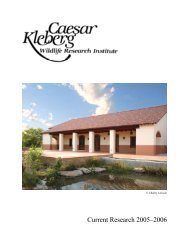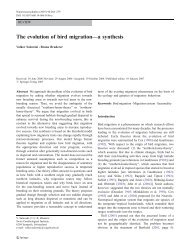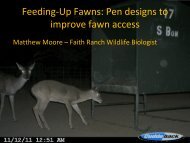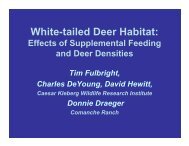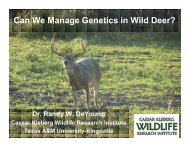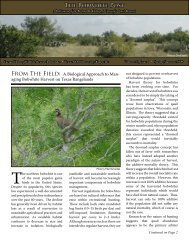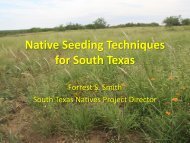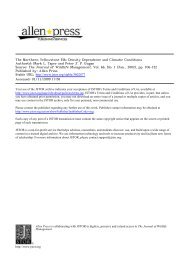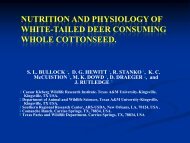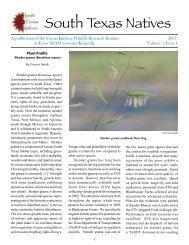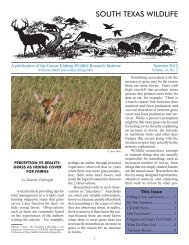A Method for Determining Asymptotes of Home-Range Area Curves
A Method for Determining Asymptotes of Home-Range Area Curves
A Method for Determining Asymptotes of Home-Range Area Curves
- No tags were found...
You also want an ePaper? Increase the reach of your titles
YUMPU automatically turns print PDFs into web optimized ePapers that Google loves.
<strong>Home</strong>-range <strong>Asymptotes</strong>A <strong>Method</strong> <strong>for</strong> <strong>Determining</strong> <strong>Asymptotes</strong> <strong>of</strong> <strong>Home</strong>-<strong>Range</strong><strong>Area</strong> <strong>Curves</strong>Aaron M. Haines 1,2 , Fidel Hernández, Scott E. Henke, Ralph L. BinghamCaesar Kleberg Wildlife Research Institute, Texas A&M University - Kingsville, Kingsville, 700 University Blvd., MSC 218, TX 78363, USA<strong>Home</strong>-range area curves are used to estimate the number <strong>of</strong> locations needed to accurately estimate homerange size based on the asymptote <strong>of</strong> the curve. However, the current methodology used to identify asymptotes<strong>for</strong> home-range area curves is largely subjective and varies between studies. Our objective was to evaluatethe use <strong>of</strong> exponential, Gompertz, logistic, and reciprocal function models as a means <strong>for</strong> identifyingasymptotes <strong>of</strong> home-range area curves. We radio monitored northern bobwhite (Colinus virginianus) coveysduring mid-September through November 2001-2002 in Jim Hogg County, Texas. We calculated home-rangesize <strong>of</strong> radiomarked coveys using the 95% fixed kernel with least squares cross validation and minimum convexpolygon estimators. We fitted area observations and coefficient <strong>of</strong> variation to the number <strong>of</strong> locationsusing exponential, Gompertz, logistic, and reciprocal function models to estimate the minimum number <strong>of</strong>locations necessary to obtain a representative home range size <strong>for</strong> each home range estimator. The variousfunction models consistently provided a relatively good fit <strong>for</strong> home range area curves and coefficient <strong>of</strong> variationcurves (0.58 ≤ R 2 ≤ 0.99; P < 0.05) <strong>for</strong> both home range estimators. We used an in<strong>for</strong>mation-theoreticframework (AICC) to select the best model to estimate area-curve asymptotes. The use <strong>of</strong> function modelsappears to provide a structured and useful approach <strong>for</strong> calculating area-curve asymptotes. We propose thatresearchers consider the use <strong>of</strong> such models when determining asymptotes <strong>for</strong> home-range area curves andthat more research be conducted to validate the strength <strong>of</strong> this method.Citation: Haines AM, Hernández F, Henke SE, Bingham RL. 2009. A method <strong>for</strong> determining asymptotes <strong>of</strong> home - range area curves. Pages 489- 498 in Cederbaum SB, Faircloth BC, Terhune TM, Thompson JJ, Carroll JP, eds. Gamebird 2006: Quail VI and Perdix XII. 31 May - 4 June 2006.Warnell School <strong>of</strong> Forestry and Natural Resources, Athens, GA, USA.Key words: area curves, home range, kernel estimator, minimum convex polygon, northern bobwhiteIntroduction<strong>Home</strong>-range size, hereafter home-range, is a parametercommonly reported in many radiotelemetrystudies (Garton et al. 2001). <strong>Home</strong>-range is affectedby factors such as time elapsed between consecutivelocations (Swihart and Slade 1985a,b), techniquesused to collect location data (Adams andDavis 1967), and the number <strong>of</strong> observations usedto obtain the estimate (Stickel 1954, Jennrich andTurner 1969, Bek<strong>of</strong>f and Mech 1984, Seaman et al.1999). Several studies have attempted to provideguidelines <strong>for</strong> calculating home-range by comparingthe per<strong>for</strong>mance <strong>of</strong> home range estimators undervarying sample sizes (Boulanger and White 1990,Worton 1995, Seaman and Powell 1996, Seaman et al.1999). However, results have been disparate (Kernohanet al. 2001).<strong>Home</strong>-range area curves have been used to estimatethe number <strong>of</strong> locations necessary <strong>for</strong> estimatinghome range (Odum and Kuenzler 1955, Bondet al. 2001, Gosselink et al. 2003). A home-rangearea curve <strong>for</strong> a species plots the number <strong>of</strong> independentlocations on the x-axis against the estimatedhome-range size on the y-axis <strong>for</strong> that particularsample size. From the resulting graph, the number<strong>of</strong> required locations is denoted when increasing thenumber <strong>of</strong> locations does not result in an increasinghome range size (i.e., the asymptotes <strong>of</strong> the graph;Odum and Kuenzler 1955). However, the methodologyused to identify asymptotes <strong>for</strong> home-rangearea curves is largely subjective and varies betweenstudies. For example, Odum and Kuenzler (1955)defined an asymptote as being the point when additionallocations produced
<strong>Home</strong>-range <strong>Asymptotes</strong>home range size, whereas Bond et al. (2001) identifiedasymptotes through visual inspection. Giventhis subjective and discordant approach, a morestructured methodology is needed to determine theoptimum number <strong>of</strong> locations necessary to producea representative home range.The objective <strong>of</strong> our study was to evaluate theuse <strong>of</strong> exponential, Gompertz, logistic, and reciprocalfunction models as a means <strong>for</strong> identifyingasymptotes <strong>of</strong> home-range area curves (i.e., areacurveasymptotes). We used radio locations obtainedfrom radio marked northern bobwhites (Colinusvirginianus; hereafter bobwhites) to develophome-range area curves and evaluate our proposedmethodology.Study <strong>Area</strong>We conducted our radiotelemetry study on aprivate ranch located 8 km east <strong>of</strong> Hebbronville,Texas in Jim Hogg County. The study area iscontained within the Rio Grande Plains ecoregion(Gould 1975). Topography within the Rio GrandePlains is level to rolling, and the elevation rangesfrom sea level to 330 m. The Rio Grande Plainsis characterized by rangeland, open prairies with agrowth <strong>of</strong> mesquite (Prosopis glandulosa), huisache(Acacia smallii), granjeno (Acacia berlandieri), andTexas pricklypear cactus (Optuntia lindheimeri). Annualrainfall ranges from 35 to 66 cm and soils rangefrom clays to sandy loams (Correll and Johnston1979). Although large acreages <strong>of</strong> cultivated landexist within the Rio Grande Plains, the predominantland use is livestock production (i.e., rangeland)(Correll and Johnston 1979).<strong>Method</strong>sWe trapped bobwhites from mid-Augustthrough September 2001 and 2002 using funnel trapsbaited with milo (Stoddard 1931) and by night nettingroosting coveys (Labisky 1968) on 3 pastures(601 ha, 1031 ha, and 1563 ha), each separated by>3 km. We banded all captured bobwhites andradiocollared any bobwhite weighing ≥150 g. Wefitted bobwhites with 6-7 g neck-loop radiotransmitters(American Wildlife Enterprises R○, Tallahassee,Florida).We monitored coveys via radiotelemetry 5 timesper week from mid-September through November2001-2002. We defined this 10-week period as the fallseason. We located coveys by homing (White andGarrott 1990) and obtained a global positioning system(GPS) coordinate using a hand-held unit with anaccuracy <strong>of</strong> ±5 m (Garmin 90 GPS). We monitoredcoveys once or twice a day during 1 <strong>of</strong> 3 time periods:morning (0700-1000 hrs.), afternoon (1200-1500hrs.), or evening (1600-1900 hrs.). These time periodscorresponded to periods <strong>of</strong> biological activity<strong>for</strong> bobwhites in southern Texas (i.e., morning feeding,afternoon loafing, and evening feeding, respectively).If 2 locations were taken during the sameday <strong>for</strong> 1 covey, then one location was taken duringa loafing period and the other during a feeding periodto obtain independent locations. However, if 2locations were taken during the same day <strong>for</strong> a specificcovey the next location taken <strong>for</strong> that covey wasnot taken until 2 days later. For example, if locationswere taken on the loafing and evening-feeding period<strong>for</strong> 1 covey on Monday, then the next locationwas not taken <strong>for</strong> the same covey until Wednesday.We followed this procedure in order that covey locationis not recorded on the same feeding or loafingsite due to temporal autocorrelation <strong>of</strong> location data.We calculated home range size <strong>of</strong> radiomarkedcoveys using the 95% fixed kernel (Worton 1989)with the least squares cross validation (LSCV)smoothing parameter, and minimum convex polygon(Mohr 1947) home range estimators within theanimal movement extension (Hooge and Eichenlaub1997) <strong>of</strong> the program ArcView 3.2 (EnvironmentalSystems Research Institute, Inc., Redlands, CA.). Wechose to use the kernel home range estimator recommendedby Kernohan et al. (2001) because it hasthe ability to compute home range boundaries thatincluded multiple centers <strong>of</strong> activity, lacks sensitivityto outliers, is based on complete utilization distribution,and is a nonparametric methodology. Weselected the fixed kernel with LSCV because it haslower bias and better surface fit than adaptive kernelMay 31 - June 4, 2006 490 Gamebird 2006 | Athens, GA | USA
<strong>Home</strong>-range <strong>Asymptotes</strong>Table 1: Mean home range size (ha), standard error, and coefficient <strong>of</strong> variation <strong>of</strong> northern bobwhite coveysover 7 location intervals using the 95% fixed kernel estimator with least squares cross validation (LSCV)smoothing parameter, and minimum convex polygon home range estimator, Jim Hogg County, Texas, USA,Sep-Nov, 2001-2003.95% Fixed MinimumKernel (LSCV) Convex PolygonYear Location Interval n a N b Mean S.E. CV c Mean S.E. CV2001 Monthly 3 14 20.69 4.55 1.22 1.05 1.02 0.94Biweekly 6 14 16.08 4.01 1.01 4.51 2.12 1.17Weekly 11 14 17.23 4.15 0.54 8.73 2.95 0.642× Week 20 14 15.32 3.91 0.43 11.06 3.33 0.673× Week 30 14 15.96 3.99 0.36 14.04 3.75 0.54× Week 40 14 15.1 3.89 0.34 14.6 3.82 0.495× Week 50 14 15.02 3.88 0.36 15.6 3.95 0.462002 Monthly 3 20 22.84 4.78 0.76 1.42 1.19 1.03Biweekly 6 20 11.18 3.34 0.74 2.74 1.66 0.53Weekly 11 20 11.34 3.37 0.52 4.69 2.17 0.42× Week 20 20 10.27 3.20 0.42 6.04 2.46 0.293× Week 30 20 11.06 3.33 0.41 8.23 2.87 0.344× Week 40 20 11.34 3.37 0.39 9.45 3.07 0.315× Week 50 20 12.06 3.47 0.41 10.93 3.31 0.3a Number <strong>of</strong> locationsb Number <strong>of</strong> bobwhite coveys observedc Coefficient <strong>of</strong> variationwith LSCV <strong>for</strong> a selected bandwidth (Seaman andPowell 1996, Seaman et al. 1999). We also chose minimumconvex polygon because we wanted to assessthis commonly used estimator (Seaman et al. 1999).We developed home-range area curves followinga protocol similar to Odum and Kuenzler (1955).We consistently obtained 5 covey locations a week.Based on this schedule we developed separate locationintervals to find the minimal number <strong>of</strong> locationsneeded to estimate bobwhite home-range sizeduring the fall season. Intervals consisted <strong>of</strong> 1 location/month,1 location every other week, 1 location/week,2 locations/week, 3 locations/week, 4locations/week, and 5 locations/week, respectively.We calculated mean, standard error, and coefficient<strong>of</strong> variation (CV) <strong>for</strong> all covey home range estimates<strong>for</strong> each location interval. From this data, we thendeveloped home-range area curves (i.e., hereafterarea curves) and CV curves <strong>for</strong> each estimator byyear.Odum and Kuenzler (1955) defined the asymptoteas the first location interval at which any additionallocations produced
<strong>Home</strong>-range <strong>Asymptotes</strong>Table 2: Model parameters resulting from fitting means <strong>of</strong> home range size (ha) <strong>of</strong> northern bobwhite coveys to the number <strong>of</strong> locationsusing 4 separate function models. <strong>Home</strong> ranges were calculated using the 95% fixed kernel least squares cross validation (LSCV) smoothingparameter and minimum convex polygon home range estimators, Jim Hogg County, Texas, USA, Sep-Nov, 2001-2003.YearEstimator Model parameters AsymptoteModel Function a b C Estimate (ha) SE −1SE +1SE AICC ∆AICC R 22001Fixed-KernelReciprocal f(x) = a + b x14.8 15.90 NA 14.8 0.38 14.5 15.2 29.1 0.0 0.85Exponential f(x) = C + a ∗ e (−b∗x) -53.0 0.80 15.7 15.7 0.32 15.4 16.0 42.7 13.6 0.86Logistic f(x) = C/(1 + a ∗ e (b∗x) ) 7.7 0.95 15.7 15.7 0.32 15.4 16.0 42.7 13.6 0.86Gompertz f(x) = 2C − C ∗ e (−e(a−b∗x) )109.3 36.76 15.7 15.7 0.29 15.4 16.0 43.0 13.9 0.85MCPExponential f(x) = C + a ∗ e (−b∗x) 18.1 0.08 15.6 15.6 0.46 15.1 16.1 37.0 0.0 0.99Reciprocal f(x) = a + b x14.6 -45.67 NA 14.6 1.04 13.6 15.6 41.0 4.0 0.89Logistic f(x) = C/(1 + a ∗ e (b∗x) ) 7.6 0.18 14.8 14.8 0.77 14.0 15.6 48.3 11.3 0.96Gompertz f(x) = C ∗ e (−e(a−b∗x) )8.3 0.82 13.8 13.8 1.08 12.7 14.9 58.7 21.7 0.822002Fixed-KernelExponential f(x) = C + a ∗ e (−b∗x) 7.9 2.94 11.2 11.2 0.12 11.1 11.3 37.8 0.0 0.99Logistic f(x) = C/(1 + a ∗ e (b∗x) ) 4.6 7.49 11.3 11.3 0.16 11.1 11.4 38.2 0.4 0.99Gompertz f(x) = 2C − C ∗ e (−e(a−b∗x) )27.0 6.51 11.3 11.3 0.16 11.1 11.5 38.2 0.4 0.99Reciprocal f(x) = a + b x9.4 34.12 NA 9.4 1.04 8.3 10.4 43.3 5.5 0.77MCPExponential f(x) = C + a ∗ e (−b∗x) 13.5 0.03 14.0 14.0 1.46 12.6 15.5 30.0 0.0 0.99Gompertz f(x) = C ∗ e (−e(a−b∗x) )0.8 0.06 11.8 11.8 0.89 10.9 12.7 35.0 5.0 0.99Logistic f(x) = C/(1 + a ∗ e (b∗x) ) 5.3 0.09 11.1 11.1 0.74 10.3 11.8 37.8 7.8 0.98Reciprocal f(x) = a + b x9.0 -26.81 NA 9.0 0.86 8.1 9.8 40.7 10.7 0.75May 31 - June 4, 2006 492 Gamebird 2006 | Athens, GA | USA
<strong>Home</strong>-range <strong>Asymptotes</strong>Table 3: Model parameters resulting from fitting coefficients <strong>of</strong> variation (CV) <strong>of</strong> home range size <strong>of</strong> northern bobwhite coveys to the number<strong>of</strong> locations using 4 separate function models. <strong>Home</strong> ranges were calculated using the 95% fixed kernel least squares cross validation (LSCV)smoothing parameter and minimum convex polygon home range estimators, Jim Hogg County, Texas, USA, Sep-Nov, 2001-2003.YearEstimator Model parameters AsymptoteModel Function a b C Estimate (ha) SE −1SE +1SE AICC ∆AICC R-square2001Fixed-KernelExponential xf(x) = C + a ∗ e (−b∗x) 1.43 0.15 0.34 0.34 0.03 0.32 0.37 4.8 4.9 0.98Logistic f(x) = C/(1 + a ∗ e (b∗x) ) -0.88 -0.04 0.28 0.28 0.06 0.22 0.34 8.8 8.9 0.97Gompertz f(x) = C ∗ e (−e(a−b∗x) )17.67 1.82 0.5 0.5 0.04 0.46 0.53 19.4 19.5 0.84MCPReciprocal f(x) = a + b x0.52 0.71 NA 0.52 0.08 0.43 0.6 8.1 0 0.58Gompertz f(x) = C ∗ e (−e(a−b∗x) )6.57 0.72 0.53 0.53 0.02 0.5 0.55 13.4 5.3 0.88Exponential f(x) = C + a ∗ e (−b∗x) 0.76 0.07 0.43 0.43 0.13 0.3 0.56 17.3 9.2 0.79Logistic f(x) = C/(1 + a ∗ e (b∗x) ) -0.79 -0.01 0.24 0.24 0.4 -0.16 0.64 17.6 9.5 0.782002Fixed-KernelGompertz f(x) = C ∗ e (−e(a−b∗x) )2.52 0.31 0.39 0.39 0.01 0.39 0.4 -11.6 0 0.99Reciprocal f(x) = a + b x0.39 1.31 NA 0.39 0.03 0.36 0.42 -5.7 5.9 0.85Exponential f(x) = C + a ∗ e (−b∗x) 0.58 0.12 0.39 0.39 0.02 0.37 0.41 -0.3 11.3 0.96Logistic f(x) = C/(1 + a ∗ e (b∗x) ) -0.64 -0.06 0.37 0.37 0.03 0.34 0.41 1.8 13.4 0.94MCPReciprocal f(x) = a + b x0.22 2.29 NA 0.22 0.02 0.2 0.25 -10.0 0 0.97Logistic f(x) = C/(1 + a ∗ e (b∗x) ) -1.15 -0.17 0.31 0.31 0.01 0.3 0.32 -9.0 1 0.99Exponential f(x) = C + a ∗ e (−b∗x) 2.16 0.37 0.32 0.32 0.01 0.31 0.33 -4.2 5.8 0.99Gompertz f(x) = C ∗ e (−e(a−b∗x) )17.02 3.02 0.41 0.41 0.04 0.37 0.45 16.9 26.9 0.80Gamebird 2006 | Athens, GA | USA 493 May 31 - June 4, 2006
<strong>Home</strong>-range <strong>Asymptotes</strong>Figure 1: <strong>Asymptotes</strong> <strong>for</strong> A) mean home range size <strong>of</strong> northern bobwhite coveys calculated using 95% fixedkernel (n = 14 coveys in 2001 and n = 20 coveys in 2002) and B) coefficients <strong>of</strong> variation (CV). <strong>Asymptotes</strong>were determined by modeling mean home range size or CV as exponential, Gompertz, logistic, and reciprocalfunctions <strong>of</strong> the number <strong>of</strong> locations (no. locations) and then identifying the best model based onan in<strong>for</strong>mation-theoretic framework (AIC C ). Arrows denote first observed value to fall within 1 standarderror <strong>of</strong> the estimated asymptote.els (SAS Institute, Inc. 2002-2004).We used the asymptote obtained <strong>for</strong> the bestmodel to estimate the minimum number <strong>of</strong> locationsnecessary to obtain a representative home range size<strong>for</strong> each home range estimator by year. We definedthis to be the minimum number <strong>of</strong> locations whenan observed point first fell within ±1 standard error<strong>of</strong> the estimated asymptote.ResultsWe monitored 14 coveys in 2001 and 20 coveysin 2002 (Table 1) with an average <strong>of</strong> 2 to 3 birds ina covey. All function models provided a relativelygood fit (0.58 ≤ R 2 ≤0.99; P < 0.05) <strong>for</strong> area curvesand CV curves <strong>for</strong> both home range estimators (Table2, 3).Using the 95% fixed kernel estimator, AICCscores were the lowest <strong>for</strong> the reciprocal model in2001 with an asymptote estimate <strong>of</strong> 14.8 ± 0.38 (ha)and scores were lowest <strong>for</strong> the exponential modelin 2002 with an asymptote estimate <strong>of</strong> 11.2 ± 0.12(ha) <strong>for</strong> mean home range size (Table 2). Based onthese estimates we determined that ≥40 locationswere required to estimate home range size in 2001,whereas ≥30 locations were sufficient in 2002 (Figure1). For the CV, AICC scores were lowest <strong>for</strong> thereciprocal model in 2001 with an asymptote estimate<strong>of</strong> 0.30 ± 0.05 and scores were lowest <strong>for</strong> the Gompertzmodel in 2002 with an asymptote 0.39 ± 0.01(Table 3). Based on these estimates we determinedMay 31 - June 4, 2006 494 Gamebird 2006 | Athens, GA | USA
<strong>Home</strong>-range <strong>Asymptotes</strong>Figure 2: <strong>Asymptotes</strong> <strong>for</strong> A) mean home range size <strong>of</strong> northern bobwhite coveys calculated using minimumconvex polygon (n = 14 coveys in 2001 and n = 20 coveys in 2002) and B) coefficients <strong>of</strong> variation(CV). <strong>Asymptotes</strong> were determined by modeling mean home range size or CV as exponential, Gompertz,logistic, and reciprocal functions <strong>of</strong> the number <strong>of</strong> locations (no. locations) and then identifying the bestmodel based on an in<strong>for</strong>mation-theoretic framework (AIC C ). Arrows denote first observed value to fallwithin 1 standard error <strong>of</strong> the estimated asymptote.that ≥40 locations were required to minimize variationin home range estimation in both 2001 and 2002(Figure 1).Using minimum convex polygon, AICC scoresin 2001 were lowest <strong>for</strong> the exponential model withan asymptote estimate <strong>of</strong> 15.6 ± 0.46 (ha) <strong>for</strong> meanhome range size and AICC scores were lowest <strong>for</strong>the reciprocal model with an asymptote estimate <strong>of</strong>0.52 ± 0.08 <strong>for</strong> the CV in 2001 (Table 2, 3). Basedon these estimates we determined that ≥50 locationswere required to estimate mean home rangesize while ≥30 locations were required to minimizevariation in home range estimation (Figure 2). TheAICC scores in 2002 were lowest <strong>for</strong> the exponentialmodel with an asymptote estimate <strong>of</strong> 14.0 ± 1.46 (ha)<strong>for</strong> mean home range size and scores were lowest <strong>for</strong>the reciprocal model with an asymptote estimate <strong>of</strong>0.22 ± 0.02 <strong>for</strong> the CV (Table 2, 3). Based on theseestimates we determined that an asymptote couldnot be reached because actual home range size andthe CV did not come within ±1 SE <strong>of</strong> the estimatedasymptote calculated by the models selected by theAICC (Figure 2). Thus, there were not enough locationsto estimate home range size using minimumconvex polygon in 2002.DiscussionBased on our modeling simulations we foundthat ≥40 locations were adequate to reach an asymptote<strong>for</strong> home range area estimation using the 95%Gamebird 2006 | Athens, GA | USA 495 May 31 - June 4, 2006
<strong>Home</strong>-range <strong>Asymptotes</strong>fixed kernel estimator <strong>for</strong> our sample <strong>of</strong> bobwhitecoveys during the fall season. Our estimate usingfield data is similar to Seaman et al. (1999) who reportedthat bias and variance <strong>for</strong> the kernel estimatorapproached an asymptote at 50 locations usingcomputer simulation points. They recommendedusing a minimum ≥30 locations to obtain homerange estimates when using kernel estimators withLSCV, but preferably ≥50.Regarding the minimum convex polygon, wedocumented that in 2001 ≥50 locations were necessaryto obtain a representative home range estimate<strong>for</strong> our sample <strong>of</strong> bobwhite coveys. However,in 2002 an area-curve asymptote was not reached toobtain a representative home range. <strong>Home</strong> range estimatesfrom the minimum convex polygon estimatorscontinued to increase with increasing locations(a property <strong>of</strong> this estimator), though this increasewas minimal in 2001. However, CV‘s remained relativelyconstant. This observation can occur becauseCV‘s are a ratio <strong>of</strong> mean:standard deviation. There<strong>for</strong>e,similar CV‘s can result in spite <strong>of</strong> increasingmeans if their corresponding standard deviationsalso increase in similar proportion. Previous researchhas suggested a much larger number <strong>of</strong> locations(100-200) to estimate home range size using theminimum convex polygon (Bek<strong>of</strong>f and Mech 1984,Laundre and Keller 1981, Harris et al. 1990). Gautestadand Mysterud (1995) believed that asymptotesusing the minimal convex polygon method wouldonly occur when using more than several thousandlocations.Kernohan et al. (2001) evaluated 12 home rangeestimators, including the estimators used in thisstudy. Overall, Kernohan et al. (2001) favored thekernel home range estimator because it required areasonable sample size (≥50 location points), hadthe ability to compute home range boundaries thatincluded multiple centers <strong>of</strong> activity, was based oncomplete utilization distribution, was a nonparametricmethodology, and lacked sensitivity to outliers.However, kernel estimators have no real comparabilityto other home range estimators due to itsestimate being greatly affected by bandwidth choice.Minimum convex polygon also is a nonparametrichome range estimator, but unlike the kernel estimatorit is not impacted by bandwidth choice andcan be compared to other estimators. However, theminimum convex polygon estimator requires a largesample size (i.e., >100 locations total), does not useutilization distribution, does not account <strong>for</strong> outliers,and does not calculate multiple centers <strong>of</strong> activity(Kernohan et al. 2001, p. 140).Regardless <strong>of</strong> the estimator used, we recommendthat verification is needed showing that an areacurveasymptote had been reached prior to homerange estimation. However, identifying the asymptotes<strong>for</strong> home-range area curves has been difficultbecause it generally has involved much subjectivity.Previous studies identified asymptotes through visualinspection (e.g., Bond et al. 2001) or when additionallocations produced
<strong>Home</strong>-range <strong>Asymptotes</strong>Haines, Keith Krakhaur, the Texas A&M University- Kingsville Wildlife Society, Lane Roberson,Eric Garza, and Conor Haines <strong>for</strong> their help in thefield and inputting data. We thank D. G. Hewitt, B.M. Ballard, and 2 anonymous reviewers <strong>for</strong> providinghelpful comments on an earlier version <strong>of</strong> thismanuscript. This project was supported by fundsfrom the Greater Houston Chapter <strong>of</strong> Quail Unlimited,The Amy Shelton McNutt Charitable Fund, TheGeorge and Mary Josephine Hamman Foundation,and by Mr. William Vogt. This manuscript is CaesarKleberg Wildlife Research Institute publicationnumber 03-116.ReferencesAdams, L., and S. D. Davis. 1967. The internalanatomy <strong>of</strong> home range. Journal <strong>of</strong> Mammalogy48:529–536.Bek<strong>of</strong>f, M., and L. D. Mech. 1984. Simulation analyses<strong>of</strong> space use: <strong>Home</strong> range estimates, variability,and sample size. Behaviour Research <strong>Method</strong>s,Instruments, and Computers 16:32–37.Bond, B. T., B. D. Leopold, L. W. Burger, Jr., and D. K.Godwin. 2001. Movements and home range dynamics<strong>of</strong> cottontail rabbits in Mississippi. Journal<strong>of</strong> Wildlife Management 65:1004–1013.Boulanger, J. G., and G. C. White. 1990. A comparison<strong>of</strong> home-range estimators using MonteCarlo simulation. Journal <strong>of</strong> Wildlife Management54:310–315.Burnham, K. P., and D. R. Anderson. 1998. Modelselection and multimodel inference: A practicalin<strong>for</strong>mation-theoretic approach. Springer-Verlag,New York, NY, USA.Correll, C. S., and M. C. Johnston. 1979. Manual<strong>of</strong> the vascular plants <strong>of</strong> Texas. The University <strong>of</strong>Texas at Dallas, Dallas, TX, USA.Garton, G. O., M. J. Wisdom, F. A. Leban, andB. K. Johnson. 2001. Experimental design<strong>for</strong> radiotelemetry studies. Pages 15–42 in J. J.Millspaugh and J. M. Marzluff, editors. Radiotracking and animal populations. Academic Press,San Diego, CA, USA.Gautestad, A. O., and I. Mysterud. 1995. The homerange ghost. Oikos 74:195–204.Gosselink, T. E., T. R. V. Deelen, R. E. Warner, andM. G. Joselyn. 2003. Temporal habitat partitioningand spatial use <strong>of</strong> coyotes and red foxes in East-Central Illinois. Journal <strong>of</strong> Wildlife Management67:90–103.Gould, F. W. 1975. Texas plants: A checklist andecological summary. Miscellaneous Publication585, Texas Agricultural Experiment Station, CollegeStation, TX, USA.Harris, S., W. J. Cresswell, P. G. Forde, W. J.Trewhella, T. Woolard, and S. Wray. 1990. <strong>Home</strong>rangeanalysis using radio-tracking data - a review<strong>of</strong> problems and techniques particularly asapplied to the study <strong>of</strong> mammal. Mammal Review20:97–123.Hooge, P. N., and B. Eichenlaub. 1997. AnimalMovement Extension to ArcView, ver. 1.1. AlaskaBiological Science Center, U. S. Geological Survey,Anchorage, AK, USA.Jennrich, R. I., and F. B. Turner. 1969. Measurements<strong>of</strong> non-circular home range. Journal <strong>of</strong> TheoreticalBiology 22:227–237.Kernohan, B. J., R. A. Gitzen, and J. J. Millspaugh.2001. Analysis <strong>of</strong> animal space use and movements.Pages 125–166 in J. J. Millspaugh and J. M.Marzluff, editors. Radio tracking and animal populations.Academic Press, San Diego, CA, USA.Labisky, R. F. 1968. Nightlighting: Its use in capturingpheasants, prairie chickens, bobwhites, andcottontails. Biological Notes 62, Illinois NaturalHistory Survey.Laundre, J. W., and B. L. Keller. 1981. <strong>Home</strong>rangeuse by coyotes in Idaho. Animal Behaviour29:449–461.Mohr, C. O. 1947. Table <strong>of</strong> equivalent populations <strong>of</strong>North American small mammals. American MidlandNaturalist 37:223–249.Odum, E. P., and E. J. Kuenzler. 1955. Measurement<strong>of</strong> territory and home range size in birds. Auk72:128–137.SAS Institute, Inc. 2002-2004. SAS 9.1.3 help and documentation.SAS Institute Inc., Cary, NC, USA.Seaman, D. E., and R. A. Powell. 1996. An evaluation<strong>of</strong> the accuracy <strong>of</strong> kernel density estimators<strong>for</strong> home range analysis. Ecology 77:2075–2085.Seaman, E. D., J. J. Millspaugh, B. J. Kernohan, G. C.Brundige, K. J. Raedeke, and R. A. Gitzen. 1999.Effects <strong>of</strong> sample size on kernel home range estimates.Journal <strong>of</strong> Wildlife Management 63:739–747.Gamebird 2006 | Athens, GA | USA 497 May 31 - June 4, 2006
<strong>Home</strong>-range <strong>Asymptotes</strong>Stickel, L. F. 1954. A comparison <strong>of</strong> certain methods<strong>of</strong> measuring ranges <strong>of</strong> small mammals. Journal<strong>of</strong> Mammalogy 35:1–15.Stoddard, H. L. 1931. The bobwhite quail: Itshabits, preservation, and increase. Charles Scribner’sSons, New York, NY, USA.Swihart, R. K., and N. A. Slade. 1985a. Influence <strong>of</strong>sampling interval on estimates <strong>of</strong> home range size.Journal <strong>of</strong> Wildlife Management 49:1019–1025.Swihart, R. K., and N. A. Slade. 1985b. Testing<strong>for</strong> independence <strong>of</strong> observations in animal movements.Ecology 66:1176–1184.White, G. C., and R. A. Garrott. 1990. Analysis <strong>of</strong>wildlife radio-tracking data. Academic Press, Inc.,San Diego, CA, USA.Worton, B. J. 1989. Kernel methods <strong>for</strong> estimatingthe utilization distribution in home-range studies.Ecology 70:164–168.Worton, B. J. 1995. Using Monte Carlo simulationto evaluate kernel-based home range estimators.Journal <strong>of</strong> Wildlife Management 59:794–800.May 31 - June 4, 2006 498 Gamebird 2006 | Athens, GA | USA



